UPSC GS 2
ULLAS-Nav Bharat Saaksharta Karyakram
- News: Ladakh has achieved a 97% literacy rate following the implementation of the ULLAS – Nav Bharat Saaksharta Karyakram scheme, making it a fully “functionally literate” administrative unit.
- Understanding Lifelong Learning for All in Society (ULLAS) -Nav Bharat Saaksharta Karyakram
- Definition: It is a centrally sponsored initiative running from 2022 to 2027. It is aligned with the National Education Policy (NEP) 2020.
- Objective: To empower adults aged 15 and above from all backgrounds who missed out on formal schooling, helping them integrate into society and contribute to the nation’s development.
- Components:
-
- Foundational Literacy and Numeracy
- Critical Life Skills
- Basic Education
- Vocational Skills
- Continuing Education
-
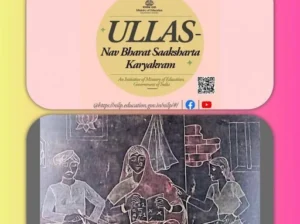
- ULLAS App: Facilitates the registration of learners and volunteers through self-registration or by surveyors.
- Digital Gateway: Provides access to a variety of learning resources via the DIKSHA portal of NCERT.
- DIKSHA (Digital Infrastructure for Knowledge Sharing):
-
- DIKSHA is the platform for providing quality e-content for school education in States/UTs.
- It is an initiative of National Council for Educational Research and Training (NCERT), under the aegis of the Ministry of Education.
- DIKSHA is built on open source technology, made in India and made for India,
- The core building blocks of DIKSHA comprise the majority of NDEAR building blocks, energized textbooks, online courses, content authoring, content sourcing, interactive quizzes, question banks, chatbot, analytics and dashboard.
-

-
-
- To support teaching and learning for Children With Special Needs (CWSN), DIKSHA offers a wide range of resources, including audiobooks, Indian Sign Language (ISL) videos, and a dictionary.
-
See this: Understanding and Addressing the Risks of Spurious Liquor | UPSC
Crime and Criminal Tracking Network Systems (CCTNS)
- News: Ahead of the implementation of the new criminal laws on July 1, at least 23 modifications have been made to the Crime and Criminal Tracking Network Systems.
- Conceptualization and Implementation:
-
- CCTNS was conceptualized by the Ministry of Home Affairs under the National e-governance plan of India.
- Implemented as a “Mission Mode Project (MMP)” since 2009.
-
- Aim:
-
- To establish a comprehensive and integrated system for enhancing the efficiency and effectiveness of policing at the police station level throughout the country.
-
- Key Features:
-
- Interlinking Police Stations: All police stations are interconnected under a common application software for investigation, data analytics, research, policymaking, and providing citizen services such as:
- Reporting and tracking complaints
- Requests for antecedent verifications by police
- Accessibility: Crime and criminal records from one police station are accessible to any other police office.
-
- Objectives:
-
- Citizen-Friendly and Transparent Policing: Automate the functioning of police stations to make police work more citizen-friendly and transparent.
- Enhanced Service Delivery: Improve citizen-centric services through effective use of ICT.
- Support for Investigating Officers: Provide tools, technology, and information to facilitate crime investigation and criminal detection.
- Improved Police Functioning: Enhance police performance in areas such as law and order, traffic management, etc.
- Information Sharing: Facilitate interaction and information sharing among police stations, districts, state/UT headquarters, and other police agencies.
- Management Support: Assist senior police officers in better management of the police force.
- Case Progress Tracking: Keep track of case progress, including court proceedings.
- Record-Keeping: Reduce manual and redundant record-keeping.
-
- Implementation:
-
- The project is implemented through close collaboration between the states and the Union Government.
-
- Nodal Agency: The National Crime Records Bureau (NCRB) is the central nodal agency managing CCTNS.
- What is an FIR?
-
- The information given to a Police Officer and reduced to writing is known as the “First Information,” and the corresponding report is understood to mean the “First Information Report (FIR).”
- The term “First Information Report (FIR)” is not defined in the Indian Penal Code (IPC), the Code of Criminal Procedure (CrPC), 1973, or any other law.
- However, in police regulations or rules, the information recorded under Section 154 of the CrPC is known as the First Information Report (FIR).
- It is the information given to a police officer in writing as per the provisions of Section 154 of the CrPC.
-
UPSC GS 3
Bannerghatta Biological Park (BBP)
- News: South India’s first and India’s largest leopard safari was inaugurated at the Bannerghatta Biological Park by Environment Minister Eshwar Khandre recently.
- History: Initially part of Bannerghatta National Park, BBP became an independent entity in 2002.
- Purpose and Expansion: To cater to the increasing interest in eco-recreation, eco-tourism, and conservation, 545 hectares of forest were initially designated for the park, later expanding to 731.88 hectares.
- Location: Approximately 22 km south of Bengaluru city, Karnataka.
- Facilities: The park has a Zoo, Safari, Butterfly Park, and Rescue Centre for the conservation of captive animals.
- Notable Feature: It is the first biological park in India to have a fenced, forested elephant sanctuary.
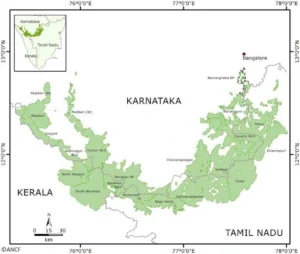
- Key Facts about Bannerghatta National Park:
- Geographical Location: Situated near Bangalore, Karnataka, in the Anekal range hills.
- Establishment: Declared a National Park in 1974.
- Unique Attractions: Home to India’s first butterfly enclosure, inaugurated in 2006.
- Water Source: The Suvarnamukhi stream, providing essential water to the park’s wildlife, flows through its center.
- Vegetation Types:
-
- Dry Deciduous Scrub Forests
- Southern Tropical Dry Deciduous Forests
- Southern Tropical Moist Mixed Forests
-
- Flora: The park boasts diverse plant species such as Narcissus latifolia, Schleichera oleosa, Sandalwood, Neem, Tamarind, Bamboo, and Eucalyptus.
- Fauna: It serves as a vital habitat for endangered Asian Elephant, Indian gaur, Tiger, Sambar deer, Spotted deer,Leopard, Wild dog, Wild pig, Sloth bear, Common mongoose, Pangolin, Slender loris, Black-naped hare.
- Additional Activities at BBP: The Minister also named a male elephant calf Swaraj and set free six hamadryas baboons for public display.
-
- Hamadryas Baboon:
- Species: The hamadryas baboon is a member of the Old World monkey family.
- Geographic Range: It is the northernmost species of baboon, native to the Horn of Africa and the southwestern region of the Arabian Peninsula.
-
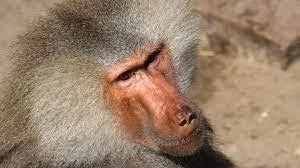
-
-
- Habitat Advantage: These regions provide habitats with fewer natural predators compared to central or southern Africa, where other baboon species are found.
- Cultural Significance: In ancient Egypt, the hamadryas baboon was considered a sacred animal and featured prominently in various roles within ancient Egyptian religion. This reverence led to its alternative name, the ‘sacred baboon’.
-
Biomass Briquettes
- News: An important innovation in the supply chain is the use of biomass briquettes as an alternative fuel for power and electricity generation.
- Biomass Briquettes:
- Composition: Biomass briquettes are compact blocks made from organic materials such as agricultural residues, forestry wastes, or industrial by-products.
- Applications:
- Uses: Commonly used for heating, cooking fuel, and electricity generation, especially in developing countries that lack access to traditional fuel sources.

- Advantages:
- Environmentally Friendly: Made from readily available biomass waste, often found in rural areas.
- Affordability: Can be produced by hand from any available organic matter, including invasive species and agro-waste.
- Carbon-Neutral: When burned, they release no additional carbon dioxide into the atmosphere.
- Greenhouse Gas Reduction: Reduces reliance on fossil fuels, helping to lower greenhouse gas emissions and combat climate change.
- Waste Management: Diverts residues towards productive use, aiding in waste management and carbon sequestration, thereby enhancing their environmental benefits.
Mainland Serow
- News: The first photographic evidence of the Mainland Serow has been documented in Assam’s Raimona National Park by forest officials.
- Description: The mainland serow is a mammal resembling a cross between a goat and an antelope. It inhabits areas at altitudes ranging from 200 meters to 3,000 meters.
- Habitat: This species of serow is native to the Himalayas, Southeast Asia, and China, with Bhutan being its natural home.
-
- Found in the Phibsoo Wildlife Sanctuary and the Royal Manas National Park in Bhutan.
-
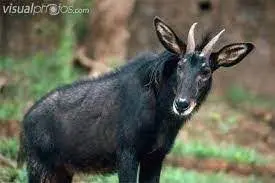
- Characteristics:
-
- Size: Around three feet high at the shoulder; typically weighs around 200 lbs.
- Coat: Possesses bristly or coarse guard hairs covering the fur closest to its skin.
- Horns: Present only in males, light-colored, approximately six inches in length, curving slightly towards the animal’s back.
- Behaviour: The mainland serow is territorial, living alone or in small groups. Females give birth to a single young after a gestation period of about eight months.
-
- Conservation Status:
-
- IUCN Status: Vulnerable
- CITES: Appendix I
-
Read also: Foundation Course For IAS/IPS/UPSC: The Ultimate Guide
Space MAITRI Mission
- News: The Australian government recently signed an $18 million memorandum of understanding with NewSpace India Limited (NSIL), the commercial arm of ISRO, under the space MAITRI mission.
- Space MAITRI Mission Overview:
-
- Space MAITRI (Mission for Australia-India’s Technology, Research, and Innovation) marks a significant advancement in the strategic partnership between India and Australia in the space sector.
-
- Key Objectives:
-
- Foster closer ties between commercial, institutional, and governmental space organizations from both nations.
- Focus on debris management and sustainability, promoting responsible space operations and mitigating the growing threat of space debris.
-
- Key Agreements:
-
- NewSpace India Limited will launch Australia’s Space Machines Company’s second Optimus spacecraft in 2026.
- The 450kg Optimus spacecraft, the largest Australian-designed and built spacecraft to date, will be launched on ISRO’s Small Satellite Launch Vehicle (SSLV).
-
- Key Facts About NewSpace India Limited
-
- Affiliation: NewSpace India Limited (NSIL) is a commercial arm under the Department of Space (DoS), Government of India.
- Establishment: Incorporated in March 2019, NSIL was set up to undertake high technology space-related activities in India.
- Role in Space Policy: Under the new space policy reforms announced by the Government of India in June 2020, NSIL is tasked with undertaking operational satellite missions on a “demand-driven” model.
- Responsibilities: NSIL is responsible for building, launching, owning, and operating satellites, as well as providing services to customers.
- Headquarters: NSIL is headquartered in Bengaluru.
-
TAPAS Unmanned Aerial Vehicle (UAV)
- News: In a major boost to enhancing indigenous unmanned surveillance capabilities of defence forces, the Indian Air Force has made a proposal to the central government to buy 10 Tapas drones.
- Tapas BH-201 Overview:
-
- The Tactical Airborne Platform for Aerial Surveillance Beyond Horizon-201 (Tapas BH-201) is a medium-altitude, long-endurance (MALE) drone.
- Previously referred to as Rustom-II, it was developed indigenously by the Aeronautical Development Establishment (ADE) of the Defence Research and Development Organisation (DRDO).
-
- Purpose:
-
- Designed to fulfill the Intelligence, Surveillance, Target Acquisition, Tracking & Reconnaissance (ISTAR) requirements of the tri-services.
-
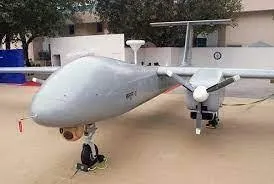
- Features:
-
- Operating Altitude: 30,000 feet
- Endurance: 24 hours
- Range: 250 km
- Payload Capacity: Up to 350 kg
- Wingspan: 20.6 meters
- Maximum Speed: 225 kmph
-
- Capabilities:
-
- Capable of effective operation both day and night.
- Can be controlled remotely and execute pre-programmed flight plans autonomously with precision and flexibility.
- Equipped with enhanced aerodynamic configuration, digital flight control, navigation system, communication intelligence, medium and long-range electro-optic payloads, and synthetic aperture radar enabling visibility through clouds.
-
Kalibr Missile
- News: A Russian submarine in the Sea of Japan has hit a land target over 1,000 kilometres (621 miles) away with a Kalibr cruise missile in a drill.
- Kalibr Missile Overview
-
- The Kalibr missile is a family of Russian cruise missiles developed and produced by Russia’s Almaz-Antey corporation.
- It is versatile, capable of being launched from ships, submarines, containers, airplanes, or transport erector launchers, and serves multiple military purposes including anti-ship, anti-submarine, and land attack roles.
-
- Features:
-
- Variants: Designed for anti-ship, anti-submarine, and land attack purposes.
- Developer: Developed and produced by Russia’s Almaz-Antey corporation.
-
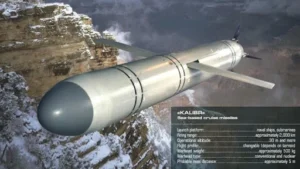
- Specifications:
-
- Mass and Length: Varies from 1,300 kg to 2,300 kg and from 6.2 m to 8.9 m, respectively, depending on the variant.
- Diameter: 0.533 m
- Warhead: Can carry a warhead weighing between 400-500 kg of high explosive or thermonuclear material.
- Propulsion: Utilizes a multi-stage solid-fuel rocket engine; some versions may include a turbojet engine or additional solid-fuel rockets.
- Guidance: Uses inertial guidance with satellite navigation update.
- Speed: Capable of accelerating to supersonic speeds in the terminal stage to evade enemy defenses.
- Range: Range varies between 200 km and 2,500 km, depending on the specific variant and type of Kalibr missile deployed.
-

